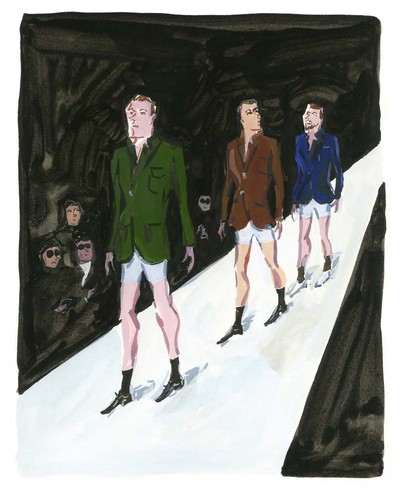Where the PowerPoint presentation meets the runway.
By Hung Huang
Illustration by Jean-Philippe Delhomme
Where the PowerPoint presentation meets the runway.

The event is one of a kind, I was told. ‘You have seen fashion shows, but you have never seen a show with just one garment – the jacket,’ the Brand VP of K-Boxing tells me. ‘We are paying tribute to the jacket, so we are doing a show with 80 jackets.’
I try to picture a show with only jackets. I see images of male models in swim trunks or just underwear – or maybe nothing, if they really want to generate buzz or scandal. K-Boxing has been selling jackets to Chinese men for 36 years. In my mind, its product is what Communist officials wear; the kind of black or navy blue windbreaker they choose when they want to dress casually. The brand has thousands of franchised stores in China and sales in the hundreds of millions of renminbi. It claims its brand name is worth over 40 billion renminbi (nearly US$6 billion). This is its first-ever fashion show.
The show venue is the Shanghai Center, the tallest building in China. Still not completely finished, it provides an amazing
view of Shanghai, if you can ignore the smell of reeking construction chemicals. The clothes, it turns out, are not only jackets but also suits and trench coats. They are good copies of Italian tailoring, with a touch of Nazi. After all, the English
name of the show is ‘Hail Jacket’.
Most successful local Chinese garment brands sells their products through franchisees, so shows are a strictly buying affair. Icicle, a high-end local women’s brand used to organize a show every season for its franchisees only. I once went to a show where there was a PowerPoint presentation right after the runway show.
Chinese brands are envious of Western brands and so all have a role model. The owner of Sept Wolf, another Chinese menswear brand, openly proclaims it as the Chinese Ralph Lauren, and K-Boxing has made various claims to be the
Chinese Louis Vuitton. But until now, the admiration would stop at boastful comparisons, because no one was willing to spend the money to build a brand.
Recently, however, Chinese fashion companies have all of a sudden cashed in on their franchise network and become all about the brand. They are doing shows, publishing books, and inviting media and key opinion leaders to previously sales-only fashion shows. There is a genuine change of attitude towards spending money on building brands. They are ready to splurge.
Two things brought on this rush to brand in China. First of all, most Chinese fashion brands built a retail consumer
base in third- and fourth-tier cities, where international brands lacked reach. Now their consumer base is being eroded by e-commerce. Even when Chinese brands are copying Western brands, copies of copies are quickly available online on Taobao, China’s version of eBay. Statistics show that almost half of fashion retail in China has moved online, forcing local Chinese brands to invest more in building their brands.
The second reason is the millennials. They want real brands; they don’t want cheap anymore. They prefer young independent designers to lacklustre established Chinese companies, which have always competed on price, not creativity. This is forcing older Chinese brands to create new stories – even if it’s a ‘story’ called ‘Hail Jacket’.
Despite this recent rush to get on-brand, I wouldn’t encourage marketing executives to quit their London jobs and rush over to Shanghai just yet. Most private Chinese companies are extremely patriarchal, with the owner sitting all Godfather-like on the throne. I worked as a consultant to a developer that wanted to brand its urban development. After entertaining eight pitches from various agencies, the owner finally decided to say no to all of them – and decided she would do it her way. The result was three days of free food and beverages for 40,000 people on site.
So even if there might be an urgent need to brand, making it a reality in China is still a long way off.